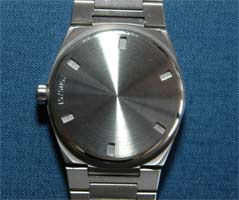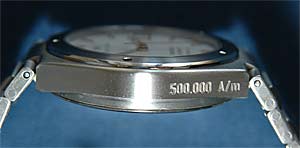
Die ref. 3508 und ihre Verwandten mit automatischem Werk (Kaliber 3759x)
 |
1989-1992/93: Die «Ingenieur 500 000 A/m»
Die ref. 3508 und ihre Verwandten mit automatischem Werk (Kaliber 3759x) |
english version |
| vorige Modellreihe | zurück zur Übersicht | nächste Modellreihe |
In IWCs jüngerer Geschichte stellt «Ingenieur 500 000 A/m» einen der glorreichsten Misserfolge dar, denn ein Misserfolg war sie zumindest in kommerzieller Hinsicht. Basierend auf dem ETA-Ebauche 2892 hatte die Schaffhausener Manufaktur während der achtziger Jahre für die Kompassuhr (Referenz 3551 mit Kaliber 37541 bzw. 37542), vor allem aber auch für die «Minentaucheruhr» der the deutschen Bundeswehr (Referenz 3519 mit Kaliber 3755AM) zwei Werke gebaut, die sich durch eine aussergewöhnliche Unempfindlichkeit gegen magnetische Felder auszeichneten. Indem man ein solch super-antimagnetisches Kaliber für ein neues Spitzenmodell der Ingenieur-Linie entwickelte, sollte das dabei erworbene technische Wissen nun aulch auf breiter Basis kommerziell genutzt werden. Ziel der Übung war es, das Werk nicht länger durch einen Weicheisenkäfig gegen elektrische Felder schützen zu müssen, sondern selbst amagnetisch zu machen.
Die hohen Erwartungen wurden schliesslich sogar noch übertroffen, als das neue Kaliber 35790 einem Magnetfeld von 3,9 Millionen A/m widertstand und dabei eien neuen Weltrekord setzte. Diese erstaunliche Leistung konnte nur dank einer Reihe von Innovationen erreicht werden. Wie bei den Kompassuhren wurde die Schwungmasse auf Rubinkugeln gelagert, neu war, dass die Spirale aus Niob-Zirkon gefertigt war, und auch an vielen weiteren Partien wie Ankerrad und Hemmungen wurden Speziallegierungen eingesetzt.
TThe Ingenieur 500,000 A/m stands for one of the most glorious failures in IWC’s later history, and a failure she was in at least a commercial sense. During the early eighties, IWC had developed two exceptional amagnetic movements based on the ETA calibre 2892, the Porsche compass watch (ref. 3551 with calibre 37541 and 37542) and the “Minentaucheruhr” for the German Bundeswehr (ref. 3519 with cal. 3755AM). Now, IWC planned to commercialise the acquired technical know-how by developing an even more resistant calibre for a new leader model of their “Ingenieur” line. The goal was not to shield the movement against magnetic fields in a soft iron Faraday’s cage as in the previous models, but to make the movement itself amagnetic.
The expectations were even surpassed when the new calibre 35790 set a new world record surviving a field of 3.9 million A/m. These astonishing results were achieved by a set of technical innovations, including using rubies as rotor ball-bearings, a special amagnetic material for pallet fork and roller, as well as a new alloy (niobium-zirconium) for the balance spring.In 1989 (or late in 1988) the new flagship was released, its name and case proudly stating the fact that the factory guaranteed it could resist magnetic fields up to 500,000 A/m. But soon technical problems emerged. The calibre 35790 proved to be very sensible to temperature changes. The troubles were caused by the hairspring whose new alloy lacked the isochronous characteristics which we take for granted in a modern watch. Basically, IWC ended up with a model which could keep accurate time even in the rare occasion when the movement was exposed to extremely high magnetic fields, but which stayed out of step in the more likely event of a sudden jump in temperature.
Of course, IWC tried everything to save its prestigious project. But its engineers found no solution how the niobium-zirconium balance spring could be mass produced with a reliable isochronous quality. For a time, each hairspring was individually tested for its temperature characteristics, and only the best suited were picked for production (only a few per mil according to M. Fitz). This testing procedure guaranteed that the “Ingenieur 500.000” met IWC high internal accuracy standards, but was of course very expensive. Most probably, it didn’t cure the fundamental problem of the movement’s susceptibility. After four years and less than 3000 pieces produced*, IWC replaced the “500,000 A/m” with the ref. 3521, a more conventional model, yet graced by an official chronometer certificate.
Today (2004), the “Ingenieur 500.000 A/m” can be regarded as a sleeper. The model is well remembered for its innovation and technical sophistication, but can still be bought at reasonable prices. With its low production number, it’s a very collectible watch, definitely from a technical point of view, but also historically most interesting. The calibre 37590 can furthermore testify against all those simplistic views which crave for inhouse movements and disqualify whole companies and lines only because of their use of bought-in ebauches. The “Ingenieur 500.000 A/m” stands as an extreme example how IWC uses its technical expertise to adapt bought-in movements until they show completely different characteristics than the original, be it for better or worse.
For a story of the “Ingenieur 500.000 A/m” see Christian Niemann, The Ingenieur 500’000 A/m - A sleeping Cinderella, in the Articles section of the English IWC-forum.
For the production problems which lead to the replacement by the “Officially Certified Chronometer” see also: Manfred Fitz, Der “Ingenieur” ist nichts zu schwer, Watch 1993/2, p.41
* Information about production number vary. Officially published sources talk of 2706 or 2755 pieces produced, but as Chr. Niemann pointed out to me, this number may include double countings and thus be far too high. In Sept. 2003, he estimated that just 1415 pieces at all were produced.
Merkmale:

| vorige Modellreihe | zurück zur Übersicht | nächste Modellreihe |